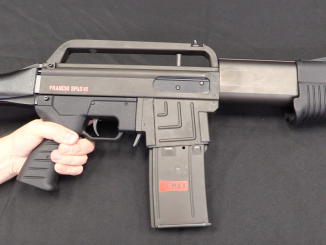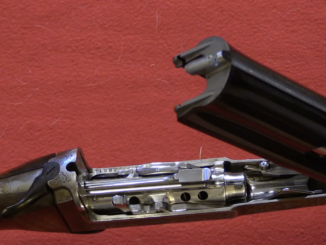The Beretta 38A is not a gun that comes to mind for many people today when discussing World War Two submachine guns, but at the time it was one of the most desirable guns of its type. So – does it live up to that reputation?
Related Articles

Shotgun
SPAS-15: Franchi’s Improvement on the SPAS-12
Lot 776 in the September 2019 RIA auction. The SPAS-15 was Franchi’s successor to the SPAS-12, improved with detachable box magazines (6 round capacity) and a construction of simple sheet metal samplings and polymer. Like […]

Shotgun
Cosmi: A Boutique 8-Round Selfloader Hiding in a Single-Shot Body
The Cosmi is a very high-end boutique Italian sporting shotgun. It has all the looks and lines of a single shot break-action gun, but hiding inside is a long recoil self-loading action and 8-round magazine […]

Submachine Guns
Benelli CB-M2 Caseless SMG
The Benelli CB-M2 was a submachine gun designed in the early 1980s around an experimental semi-caseless 9mm cartridge developed by Franchi. The gun itself looks fairly typical, with conventional controls, a bottom-mounted magazine, and polymer […]

Expensive as hell but easy to use and it dishes out nasty damage up to 200 meters away. And it’s nasty when used as a club! I don’t like the taste of walnut wood in the morning… or at any time of day. To think everyone wants one in 1940…
My understanding is that late in WWII, like 1944, the Germans actually halted all production of the MP40 and since they occupied much of Italy, including the heavy industry in the north along with the rump client-state of Mussolini’s RSI Salo State, and had effectively systematically looted the Italian armed forces arsenals in their possession, the Beretta 36 and 38/42 etc. became something of the “go to SMG” for the German armed forces, and not just the Fallschirmjäger who had taken to them in previous fighting.
Thus, the MAS 38 and derivatives played an important role in the Italian army, both Axis and Allied, the paratiggiani/partisan movement, the German armed forces, etc. etc. In something of a historical irony, the late war occupation of Italy also ensured that those Nazi-led militia Volkssturmmänner that had firearms typically carried one or another Carcano bolt action rifle or carbine…
Sorry.. typos: MAB as in Marengoni moschetti auto… Not MAS, the gun used to whack Mulossini, I mean Mussolini… Also number keys. Here’s a blast from the past…Or blasters from the past at any rate:
https://www.youtube.com/watch?v=goF255Qc3Ew
MAB mean Moschetto Automatico Beretta
Grazie
A relatively long barrel and short receiver compared to many such guns. And yet, despite the short bolt travel, a manageable cyclic rate. Impressive.
I do not see that bolt travel as unusually short (perhaps debatable point). What yields manageable ROF is likely proper balance between bolt mass and spring constant/ rate. Less stiff spring and heavier bolt usually work the best.
Again, good show – Beretta SMG very stable indeed. One thing to spot immediately is the large ejection port; the next is amount of material to make receiver strong and finally plenty of overtravel. What else to ask for? Oh yeah, double stack – 2 position mag; check! Done.
One loose afterthought: how MP38 would compare?
Not sure, but MP38 wasn’t all that great either for comfortable shooting or for mass production. Can we get a Bergmann MP35 and compare ergonomic traits?
The MP38 was hurt with its unwieldy folding butt. If it was something like Bergmann, then it might have been a superb SMG.
” If it was something like Bergmann, then it might have been a superb SMG.”
There wooden stock variant of MP 40, namely
M. P. 41
PATENT SCHMEISSER
C. G. HAENEL, SUHL
https://modernfirearms.net/en/submachine-guns/germany-submachine-guns/mp-41-schmeisser-eng/
(not to be confused with MP 41(r) which accepted same magazines, but otherwise was unrelated)
Excellent find; you are the ‘go-to man’!
For me it seems that MAB 38 was… late (hope it is proper word) – solid choice when compared to other sub-machine guns of its generation (like, for example MP.28) but introduced much later (1938 as name imply) near end of era of sub-machine guns created by a lot of machining. Not only this Italian weapon has such bad luck, as sub-machine gun evolve slower in this case it only mean that it was just expensive, but still perfectly effective, in case of Carro Armato L6/40 http://www.tanks-encyclopedia.com/ww2/italy/Carro_Armato_L6_40.php not so much.
I’ve got book information on this SMG for years and all call this the best of the lot as far as quality and reliably is concerned.
Molon Labe!
Keep your powder dry and your faith in God.
Hmm. Owen vs. MAB 38 vs. UD42 vs. …
I really like the dual triggers!
“Owen”
Owen Machine Carbine has single trigger and three-position selector lever (safe, single, full – though I am not sure about order), similarly to Thompson sub-machine gun
I fire metal cartridges and know science is real.
I’ve seen photos of Italian troops in North Africa with these SMGs–with 10 rd magazines! I’d guess that’d be for semi-auto only. Maybe for ease of carry on the march? No long magazine sticking out, but you have a bit of ammo just in case. If things go kinetic, slip in a 40 rd’er.
The Modello 38A was a very popular “acquisition” with British SpecOps forces in the Western Desert campaign (SAS, LRDG), because of the SMGs available, it was lighter than the American Thompson, more accurate than the German MP38/40, and more reliable than either one in the hot, sandy conditions prevailing. It was also more controllable in autofire than either of the other two.
Its controls were a good bit more “instictive” than either of the other two. Front trigger=single shot; rear trigger=full auto. As for the safety, Forward=Fire, Back=Safe. It dorsn’t get much more “instinctive” than that.
The M38A was also the main reason the British Sten Gun was a 9 x 19mm. When the Italian forces in libya surrendered (the first time) in 1940, among the booty the British got was several million rounds of hot-loaded 9 x 19mm for the M38As. Since the Sten was under development at the time, and no British pistol round was suitable for an SMG (the 0.380in revolver aka .38 S&W wasn’t going to work, the .455 Webley SL round wasn’t powerful enough, and .45 ACP ammunition had to be imported), they settled on the 9 x 19mm based on availability and the fact that pretty much everybody on “the other side” was already using it.
Incidentally, contrary to popular belief, Sten Guns were rarely seen in the desert war. By the time production of the Sten MK II (the most common version) was established, it was late 1942, and the major demand for them was with the Commandos and the various resistance groups on the European continent. By the time Stens were available for other theaters in early ’43, the remains of the Afrika Korps was bottled up at Tunis, and it was all over bar the shouting in North Africa.
Without a doubt, the Thompson, the MP38/40, and the Beretta M38A were the “default” SMGs “up the blue”.
cheers
eon
” no British pistol round was suitable for an SMG”
There was Dinely machine carbine: http://firearms.96.lt/pages/Dinely.html
designed around 1939 IIRC and firing 7,65 mm Browning (.32 Auto) cartridge.
Australian Owen has similar problems to Sten – lack of suitable cartridge.
Sorry eon, I beg to differ: the MAB38 has never been widespread up until 1942, and the production of 9×19 did not ramp up till 1943, just in time to support the effort to defend Tunisia ( http://cesimmunizioni.eu/forum/ecra/9m38ricci.pdf , among other sources). The quantity of working MABs and their ammunition which ended up into british hands in 1940 was a small one, certainly not into the realm of millions of rounds: “When the Italian forces in libya surrendered (the first time)” – those who surrended where mostly local native forces and 3nd class units, hardly equipped with anything modern (see also: https://www.youtube.com/watch?v=-qOEh_DwJR0 ), while the others who could not retreat dug in till running dry of supplies (i.e. https://en.wikipedia.org/wiki/Siege_of_Giarabub). The number of captured MABs was very small until after the second battle of EL Alamein.
http://miles.forumcommunity.net/?t=58626182
https://www.scribd.com/document/249021708/Moschetti-Automatici-Beretta-pdf
An interesting thread about the MAB38 and another link to a series of articles about it from vintage italian firearms magazine – with schematics, disassembly, variants, accessories, magazines…
Very good mags; they were used by seemingly all Italian SMG designs up through the PM12 (and beyond?)
Trivia the bolt was 150mms long and the max dia. was 30mms
Its weight was approx. 625 grams but as this was a neutrilized bolt with the front ground off at an angle I would suppose the original weight was 650 grams
The sear catch is located 47mms from the end of the bolt
Beretta 38 is a dream to shoot. Beautiful SMG, on the range, at least – I have no opinion on them in the field.
I first came across this gun when reading the adventures of David Drummond, fighting in the Mau Mau war in Kenya in the 1950s.
His use of this gun resulted in him being christened Bwana Drum by the Mau Mau. The book (by Dennis Holman) of the same name is well worth seeking out, it is an excellent read.